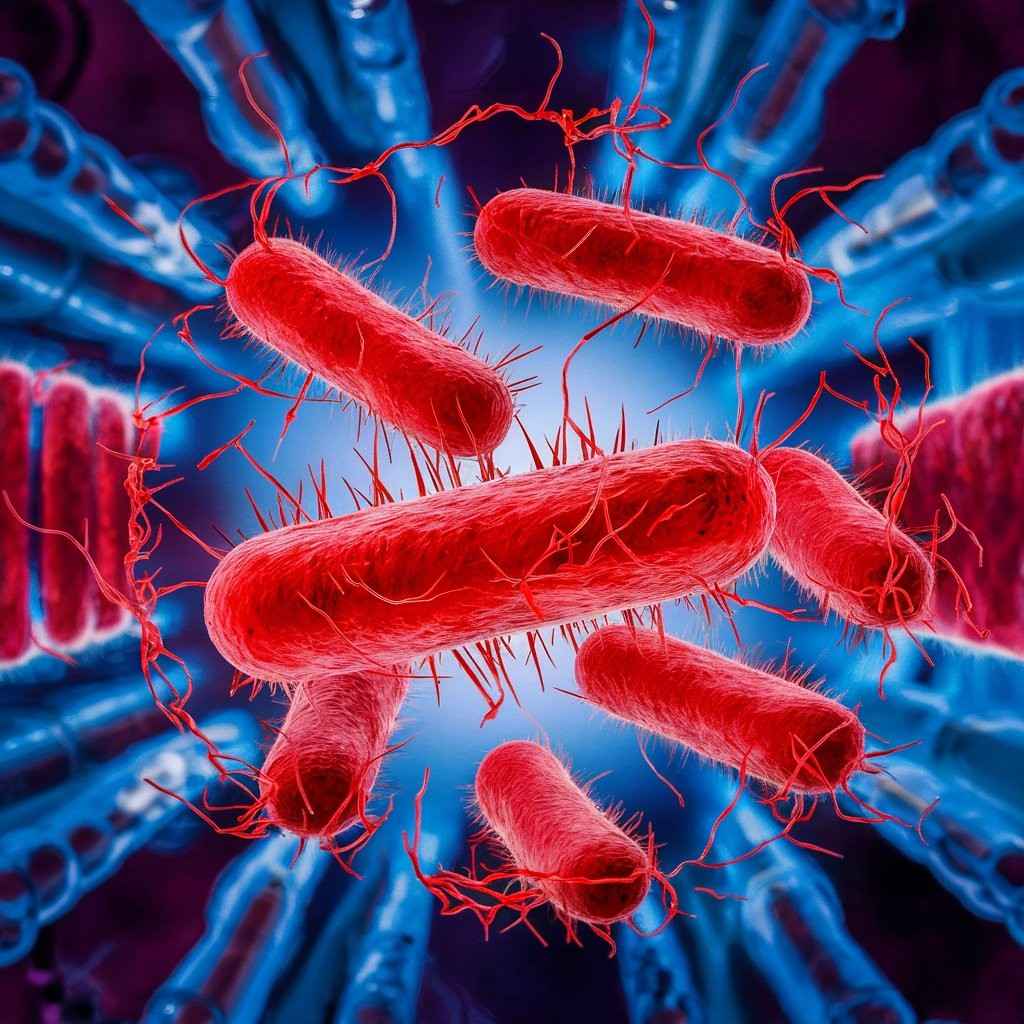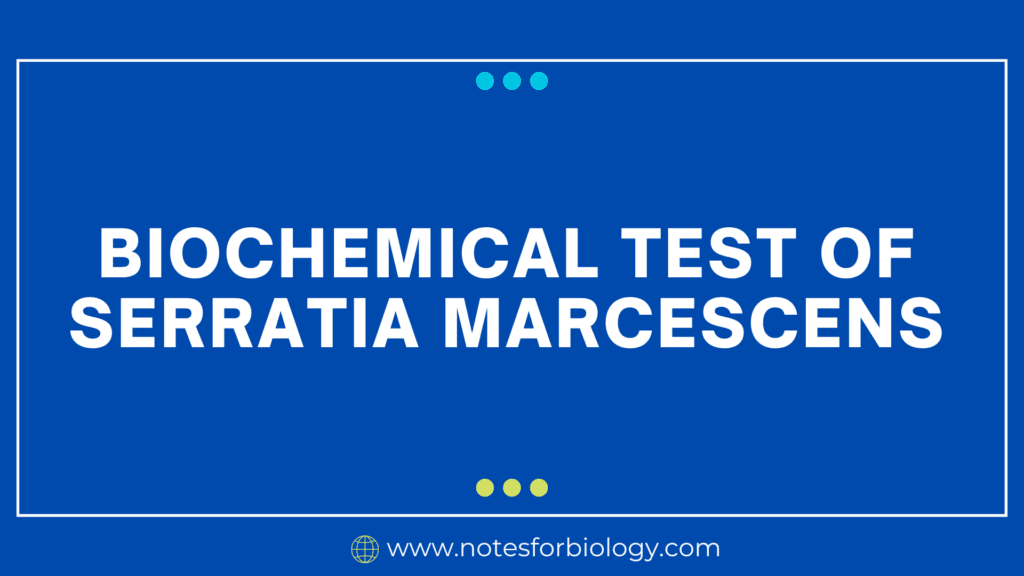Enterobacteriaceae is a family of bacteria that includes the rod-shaped, gram-negative bacterium Serratia marcescens. It is frequently discovered in soil, water, and the digestive systems of both people and other animals. Human infections caused by Serratia marcescens can include bloodstream infections, wound infections, urinary tract infections, and respiratory tract infections.
Numerous biochemical assays may be carried out in a laboratory environment to detect Serratia marcescens. These assays aid in identifying its metabolic traits and setting it apart from other bacteria.

Table of Contents
1. Gram Staining in biochemical test of serratia marcescens
For this test, bacterial cells are stained with crystal violet dye, then washed with an alcohol solution and iodine solution. Under a microscope, Serratia marcescens shows as pink/red rods following safranin counterstaining. Its Gram-negative status is shown by this.
2. Catalase Test in biochemical test of serratia marcescens
The catalase enzyme, which converts hydrogen peroxide into water and oxygen gas, is produced by Serratia marcescens. When hydrogen peroxide is added to a Serratia marcescens colony or culture, bubbles of oxygen gas are formed, indicating a positive catalase test result.
3. Oxidase Test in biochemical test of serratia marcescens
By using the oxidase test, bacteria that generate cytochrome c oxidase (positive) may be distinguished from those that do not (negative). In this test, a colony or culture of Serratia marcescens is placed on filter paper, and a drop of oxidase reagent (such as N,N,N’,N’-tetramethyl-p-phenylenediamine dihydrochloride) is applied. If the oxidase strip is positive for cytochrome c oxidase, it becomes dark blue or purple in 10–20 seconds.
4. Citrate Utilization Test in biochemical test of serratia marcescens
The citrate utilization test uses the enzyme citrate lyase, which produces alkaline products like ammonia during metabolism, to evaluate if an organism can use citrate as its only carbon source for development. Growth on Simmons’ Citrate Agar medium combined with a green to blue color shift owing to alkalinity brought on by ammonia synthesis signals success.
5. Motility Test in biochemical test of serratia marcescens
Cells exhibiting flagella on Serraita Marcessence are actively motile.
Peptone (·3%), tryptone (·1%), NaCl (·5%), glucose (1%), K2HPO4 (.2%), KH2PO4 (.8%), agar (1.5%), bromothymol blue (.002%), and L-tryptophan (·01%) are the ingredients of the motility, indole, ornithine, lysine, glycerol, and asparagine agar (MIOGA) medium. When Serratia marcescens grows or spreads across the medium, the test for motility is positive. This means that Serratia marcescens is mobile.
6. Indole Test in biochemical test of Serratia marcescens
Serratia marcescens usually produces a negative response on the Indole Test, meaning that it lacks the enzyme tryptophanase, which is needed to convert tryptophan to indole. When Serratia marcescens cultured in tryptone broth is subjected to Kovac’s reagent test, the reagent layer remains yellow and neither red nor pink color appears. One key feature that sets Serratia marcescens apart from other Enterobacteriaceae family members that are positive for indole is the result of the indole test being negative.
7. Citrate Utilization Test in biochemical test of serratia marcescens
In most cases, Serratia marcescens passes the Citrate Utilization Test, proving that it can use citrate as its only carbon source. Serratia marcescens develops and turns the medium blue after being inoculated on Simmons Citrate Agar, indicating an alkaline response. This affirmative outcome aids in distinguishing Serratia marcescens from other members of the Enterobacteriaceae family that lack the ability to use citrate.
8. Urease Test in biochemical test of serratia marcescens
When Serratia marcescens is tested for urease, the results are usually negative, meaning that the bacteria is not capable of producing the urease enzyme, which hydrolyzes urea into ammonia and carbon dioxide. Serratia marcescens does not become pink when inoculated into urea broth or agar that has phenol red added as a pH indicator, as would be expected in a good outcome. Within the Enterobacteriaceae family, Serratia marcescens may be distinguished from urease-positive bacteria, including Proteus species, thanks to this negative urease test result.
9. Hydrogen Sulfide (H2S) Production in biochemical test of serratia marcescens
For Serratia marcescens, the Hydrogen Sulfide (H₂S) Production Test usually produces a negative result. This test evaluates an organism’s capacity to convert sulfur-containing substances into hydrogen sulfide gas. No black precipitate appears when Serratia marcescens is cultivated on media like Triple Sugar Iron (TSI) agar or SIM (Sulfide, Indole, Motility) medium, showing that hydrogen sulfide generation is absent. Within the Enterobacteriaceae family, this negative result aids in distinguishing Serratia marcescens from H₂S-positive bacteria, including Salmonella species.
10. Lactose Fermentation in biochemical test of serratia marcescens
Usually, the Lactose Fermentation Test results for Serratia marcescens are negative. The purpose of this test is to evaluate the bacterium’s capacity to ferment lactose and generate gas and acid as byproducts. Serratia marcescens does not ferment lactose, hence there is no color change or acid generation when it is cultivated on medium like MacConkey agar, EMB agar, or in phenol red lactose broth. Colonies on MacConkey agar do not become pink; conversely, the medium in phenol red lactose broth does not turn yellow; instead, it stays red. Within the Enterobacteriaceae family, this negative lactose fermentation outcome aids in distinguishing Serratia marcescens from other lactose-fermenting bacteria such as Escherichia coli.
Frequently Asked Question
1. What is the Gram stain result for Serratia marcescens?
Serratia marcescens is Gram-negative, appearing pink under a microscope after Gram staining.
2. Is Serratia marcescens oxidase-positive or oxidase-negative?
Serratia marcescens is oxidase-negative, meaning it does not produce cytochrome c oxidase.
3. Does Serratia marcescens produce catalase?
Yes, Serratia marcescens is catalase-positive, producing the enzyme catalase that breaks down hydrogen peroxide into water and oxygen.
Related Article

